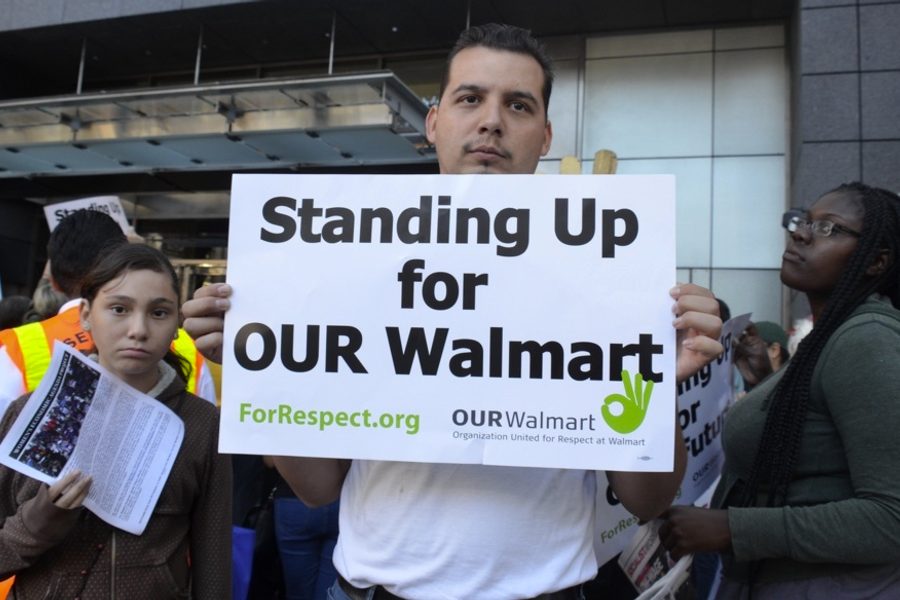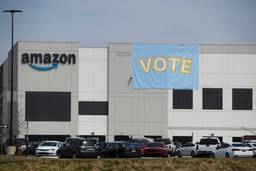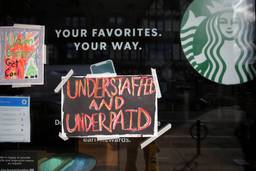
Within the labor movement, we never want to share publicly critiques of our work that might be utilized by our class enemies — in this case, Walmart. I appreciated the energy and excitement among the participants in the OUR Walmart campaign and observers who saw it as a potential renaissance moment for labor. I didn’t want to be perceived as an old crank pissing on a new parade that didn’t fit my measure of what worker organizing should be. And I have long thought the campaign was helping create a national climate for an increase in the minimum wage for all workers. That certainly was a good thing.
But my reticence to make such critiques public has now been overridden by other considerations. For one thing, the campaign’s weaknesses are and were never a secret. Walmart bosses have been well aware of the campaign’s problems and lack of support among workers.
Second, the OUR Walmart model is not unique. Other campaigns based on it include the Fight for 15 campaign and the Restaurant Opportunities Center (ROC). It is a model that needs to be carefully examined and challenged if we are going to successfully organize masses of workers.
I hope my criticisms can serve as constructive discussion on the way forward. I have no desire to participate in the game of criticism that snipes at those doing the work in the field; nor am I institutionally involved in one-or-another of the points of view discussed here. I’m simply a longtime labor organizer who wants to see a campaign against Walmart win someday — and I’m convinced that the campaign we’ve seen against Walmart thus far is not a path to victory.
OUR Walmart 2.0?
As I watched the “relaunch” of the OUR Walmart campaign in mid-September, I was reminded of those moments when a romantic relationship comes to an end, but one or both of the parties, longing to keep the spark alive, talks about how they will remain friends — or at least get together for coffee every once in awhile. Often neither person wants to confront the fact that the relationship is over. The ritual is always laced with a lot of profound emotion and tears flow freely.
The same seemed true of the new OUR Walmart 2.0. At the relaunch, I counted 12 Walmart workers, mostly Latina and African-American women, most of whom had been fired, present for the event. Sprinkled between proclamations of support from community groups, religious leaders, philanthropic foundations and politicians were their statements of commitment. Without fail, the workers broke into tears while speaking about their discharge and their hope for the campaign. I was close to tears as well, admiring the bravery behind the actions they had taken.
But I also felt we were watching the burial of a campaign — not a relaunch.
The organizers of OUR Walmart felt compelled to relaunch the campaign because it had been dramatically defunded by the United Food and Commercial Workers (UFCW) union, which had bankrolled the initiative since its beginning five years ago. The union’s new President, Mark Perrone, had decided to focus more on regional organizing work and give up the direct organizing of Walmart workers.
Without the multi-million dollar annual budget from UFCW, any true national organizing project around Walmart simply isn’t possible. At the re-launch, organizers talked bravely about continuing the campaign. But the truth was, the campaign was already in decline — and had been struggling even with UFCW funding. The campaign’s organizers admitted that the level of actual worker participation in strikes had declined between Black Friday 2012 and Black Friday 2013.
There will probably be lingering attempts on future Black Fridays to create a media mirage of activity. But experienced organizers can count and so can Walmart managers. Facebook hits and likes do not make a real organizing program. Real people risked-and at times lost-their jobs waging the Walmart campaign. Worker firings and casualties might create good social media and a public climate for improved wages, but they aren’t necessarily a positive for organizing more workers, particularly when there is no organization built that can have a reasonable chance of defending those workers.
OUR Walmart was not the first attempt at taking on the giant retailer. Both SEIU and UFCW had funded initiatives largely aimed at damaging the brand name and preventing Walmart from establishing stores in key urban markets, thus protecting unionized employers and workers from the downward economic pressure of Walmart’s low cost model. ACORN, with funding from UFCW and SEIU, had organized retail workers in Central Florida in 2005. The UFCW had organized the Tire and Lube department at a Walmart store in Quebec in 2008, which closed in response. The meat department of 10 workers in a Texas store was organized and promptly closed in retaliation in 2000.
But OUR Walmart, launched in 2010, was the first nationwide attempt to organize the workforce. The new initiative was launched with a goal of organizing 1% of the workforce (10,000) workers in one year. After half a decade and millions of dollars, this mark was never met. Walmart knew that the campaign had no substantial base among their employees as they watched “strikes” in which a handful of workers participated in community actions at stores employing over 300 workers. OUR Walmart chief strategist Dan Schlademan was quoted in the New York Times in October 2012 saying his union represented 88 employees that were on strike at 28 stores in 12 states — a small drop in the bucket of Walmart’s 1.3 million employees and 4,618 stores.
While the few workers would return to work successfully after this strike and others, the campaign was unable to defend them months later when the company canned them for other alleged violations. These minority actions were often glorified as an example of the “militant minority” strategy employed by the fledgling UAW against the giant auto manufacturers in the 1930s. While it is true that much of the successful organizing of the auto industry was done by a militant minority, it was a militant minority of thousands of strategic workers positioned to inflict real damage on the production chain — not a handful of symbolic “strikers.”
OUR Walmart was a public relations irritant to the company, but it never was a strategic challenge to Walmart’s power or its business model. Perhaps the campaign contributed to recent increases in minimum wages; perhaps it contributed to the growing national conversation about increased inequality; perhaps Walmart’s recent increase in its starting hourly wage to $10 was result of this campaign (though it may also have been the result of tightening labor markets because other employers have raised their wages as well).
But none of these is “organizing,” and none builds a powerful union.
Scale organizing
To explain why this is, let’s return to the auto industry organizing example. The organization of the auto industry was built on many years of trial and error and the presence of communists and socialists and independents in the auto plants that had organized and agitated to build a base among workers for decades. No such experience or presence existed in Walmart.
Further, the UFCW, facing its own market challenges, was not a national fighting machine of committed members who were ready to take on Walmart. This is a serious problem because long-term dedication to a campaign like OUR Walmart cannot simply be dictated from top union leadership on high. If the members whose union dues are bankrolling a campaign are not firmly committed to it, eventually there will be election consequences and new leaders will come to power, and they will cut funding and use it for more modest ventures.
Secondly, the OUR Walmart campaign never really organized around the company’s strategic weak points. OUR Walmart organized brief mini-strikes mostly among Walmart retail workers, but the company’s real strength as a company is its logistics model. Edna Bonacich and Jake B. Wilson write about Walmart’s business model in their essay “Hoisted By Its Own Petard” in New Labor Forum:
Giant retailers like Walmart are no longer simply the outlets for the goods produced by other companies. Rather, they exercise increasing control over suppliers, shaping every aspect of their production and distribution, including their pricing and labor practices. Although their stores and sales are the most visible aspect of the company to the public, there is a whole underbelly of procurement and logistics that rarely receives the same notice.
If we really seek to build power among Walmart workers, it will require the organization of their supply chain.
Organization of retail workers at stores is not sustainable without the company’s proprietary distribution centers (DCs). The Warehouse Workers United effort in Southern California (which was folded in late 2012) evolved into organizing Walmart third party logistics (3PL) providers. These are independent companies that giant big box retailers hire to handle a piece of their supply chain management. Walmart relies on 3PLs for gross cargo moves, but the order fulfillment for particular stores is done in over 200 Walmart-owned million square foot DCs, often located in semi-rural areas. These warehouses do not primarily use temps and Walmart directly hires its own truck drivers for the transport of goods from the warehouses to the stores. These workers are better compensated than 3PL contracted temps, and they have benefits. Walmart knows where the strategic workers are in their operation and they take care of them to try to mollify discontent. This is where power lies in the Walmart model.
Penetrating this workforce takes time and patience, but these workers are not bought-off aristocrats. They make wages in the high teens but suffer from speed-up and forced overtime. They are constantly racing against the clock to fulfill production quotas. They are not as quick to move as the temps, but with time and commitment by organizers, they can be motivated to take action. OUR Walmart never made this a serious priority.
Crawl before you walk, walk before you run
The UFCW presently bargains regionally with national supermarket chains and retail pharmacies. These chains are often very profitable and powerful, despite the pressure Walmart exerts upon them. There is no lack of heroism and grit among UFCW locals on a regional basis — see the Southern California supermarket strike of 2002-2003 as a prime example. But the battle against national chains must be organized and fought nationally to avoid being whipsawed by giant corporations.
Many regional and ethnic markets remain non-union. UFCW Local 770 and 324 in Los Angeles are engaged in a multi-year campaign to organize El Super grocery stores. This is a regional chain in the Southwest with 56 stores catering to the Latino market and owned by the Chedraiu Group, the third largest retailer in Mexico. This battle has gone on for three years and could benefit from the national focus and attention that Walmart got.
If we can’t win El Super, how do we win Walmart? Why not build up your organizing muscle and build up the passion and commitment of the members who see the strength of their union and can be apostles to Walmart workers?
Walmart and labor’s rebirth
The idea of resurrecting the labor movement by organizing Walmart resonated with many labor leaders and activists. With union density in decline and Walmart on the rise, victory at Walmart would signify rebirth. But we should ask some hard questions about this assumption.
Do we have a base and power with the organizing target? Are some of their facilities already unionized? Are their logistics providers unionized and the workers and their unions supportive, in the case of retail? Have we built a base among the workers in logistics? Does the union funding the organizing have a commitment among its members to the project? Have the members been willing to participate in bargain-to-organize strategies (BTO) that use their existing bargaining strength to grow? Are the members committed to an additional assessment on their dues that funds such an ambitious campaign? Have they signed on to put in their own volunteer time to organize externally? Are there smaller initiatives where we can build up our power to later slay the bigger dragons? Are there smaller feasible targets that build our strength and experience to take on the big prizes like Walmart? OUR Walmart never seemed to seriously consider such questions.
The allure of the big organizing prize is attractive. I was involved in the attempt to organize the Los Angeles manufacturing workforce, made up mostly of immigrant workers, in the 1990s under the banner of the Los Angeles Manufacturing Action Project. LAMAP inspired unions to think big and dream. Ten unions participated in funding strategic research in multiple industrial sectors in the LA basin. In 1994, the first year of the project, there were one million manufacturing workers in LA County. Over half of the workforce was immigrant Latinos.
Unions drooled over the potential for labor revitalization, and while the project was ultimately the victim of AFL-CIO politics and International Brotherhood of Teamsters (IBT) upheaval, there was not enough attention given to the issue of existing base, union member commitment and strategic leverage, and how all three could have been used to win the campaign.
The one moment that held real promise for the campaign was the decision to go all in with a 10-week strike in 1995 by tortilla delivery drivers at Grupo Maseca, the owners of Mission Guerrero tortillas. These workers had been previously organized by the IBT and were in their second contract cycle. The Teamsters asked LAMAP for help, and LAMAP’s Organizing Director Joel Ochoa correctly predicted that there was no future for LAMAP if we didn’t win the Mission Guerrero strike.
The subsequent victory ensured the support of the powerful IBT Local 63 and was the beachhead for real organizing among the 1,000 production workers at Mission. The IBT international and Local 63 were all in for this project, but the turbulence at the top of the union that toppled Teamsters for a Democratic Union-backed reform president Ron Carey meant the end to funding and support for LAMAP and the demise of the project. The idea of organizing immigrant industrial workers would have been realized in the tortilla sector, but only because of the existing base and the commitment of the local union.
Winning campaigns are often characterized by bold actions based in strategic strengths. The Justice for Janitors campaign is an illustrative example. It combined an industrial strategic vision with community support and captured the imagination of the public in many urban markets. But it was not “blank slate” organizing. The union had thousands of members in the major metro markets of New York, Chicago and San Francisco. There were excellent labor agreements with many of the same companies that were to be organized in the non-union markets. These three urban centers were the wellsprings of support and leverage for the program.
Other examples exist of using strategic strength to organize new workers. In 2013, UNITE HERE completed multiple years of bargaining with the Hyatt Corporation that resulted in bargaining rights at formerly non-union properties around the country. The United Autoworkers are having success in the organization of auto parts workers in their traditional strongholds in the Midwest, but also in the new auto production complexes springing up in the newly industrialized South. In April 2014, workers at a Toledo auto parts company supplying parts to Jeep struck for an eight-hour shift and won union recognition.
All these campaigns have in common existing assets of workers and contracts that can be deployed strategically in the service of new organizing.
Walmart is a big prize and because of that it is very alluring as a target. Success at Walmart will come with a deep commitment on the part of the UFCW and its members to a winning program. That commitment will come through education, internal organization and the confidence from winning smaller fights against regional and niche markets. It is not too soon to start thinking about a long-term salting plan for Walmart’s warehouses, as these are the power nodes of the Walmart model. Some of the millions that have been spent on the external campaign need to be invested in the fundamentals of long-term internal organizing in preparation for contract fights with existing employers so that there is readiness for external organizing.
Growing the labor movement in strategic sectors is a long and plodding process. There are no shortcuts. PR brilliance and social media slickness are no substitutes for the patient and large-scale laborious one-on-one approach.
I once discussed the OUR Walmart battle with a committed campaigner in the midst of the campaign’s heyday. I suggested that the Walmart owned distribution centers needed to be focused on. He responded that these workers are “too slow to move, that it will take to long.” Well, that was over three years ago, and the campaign went on for another three years. It’s now over, and what do we have to show for it?

I hope you found this article important. Before you leave, I want to ask you to consider supporting our work with a donation. In These Times needs readers like you to help sustain our mission. We don’t depend on—or want—corporate advertising or deep-pocketed billionaires to fund our journalism. We’re supported by you, the reader, so we can focus on covering the issues that matter most to the progressive movement without fear or compromise.
Our work isn’t hidden behind a paywall because of people like you who support our journalism. We want to keep it that way. If you value the work we do and the movements we cover, please consider donating to In These Times.
Peter Olney is the retired Organizing Director of the International Longshore and warehouse Union (ILWU). He has been a labor organizer for over 40 years.




